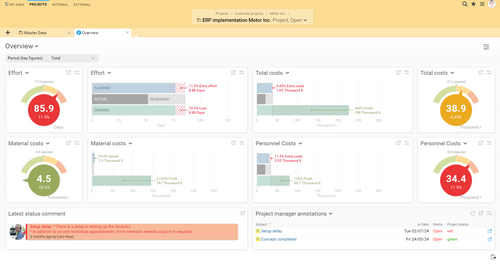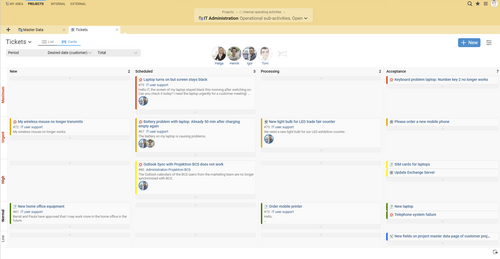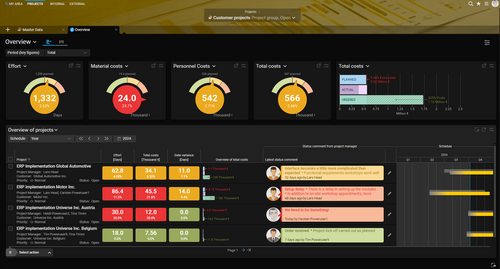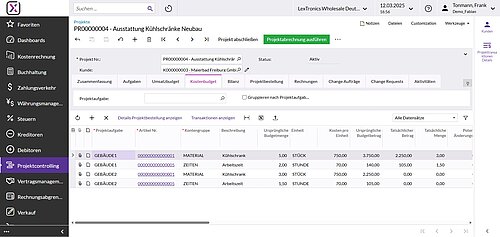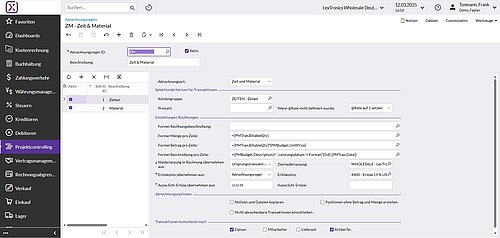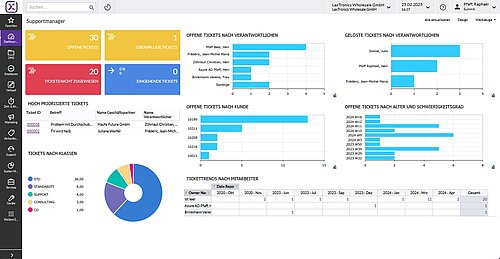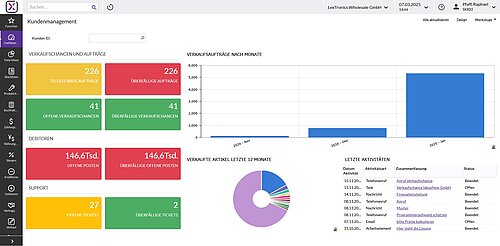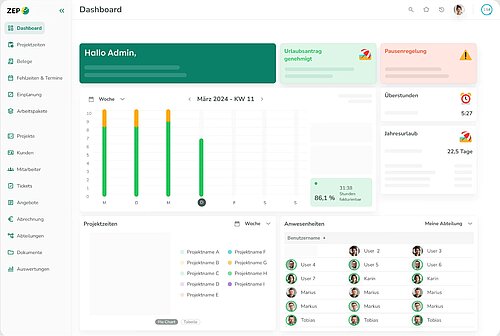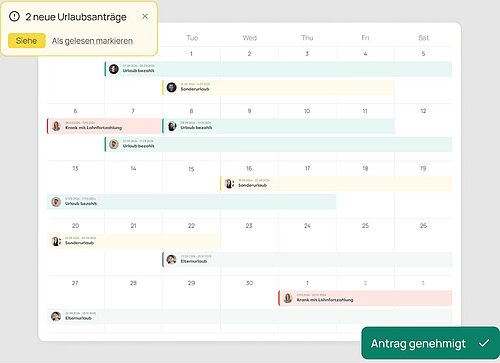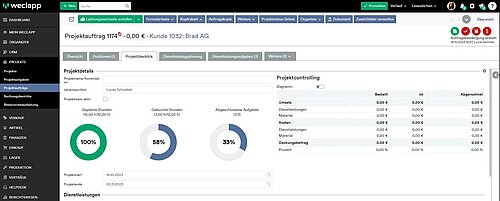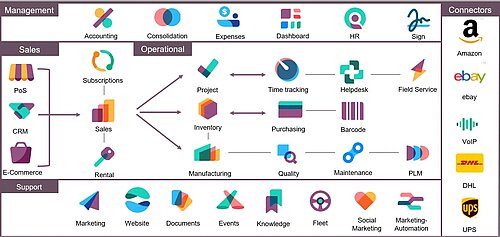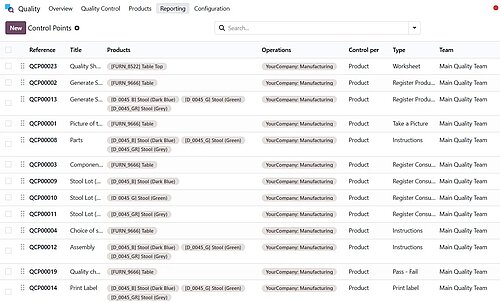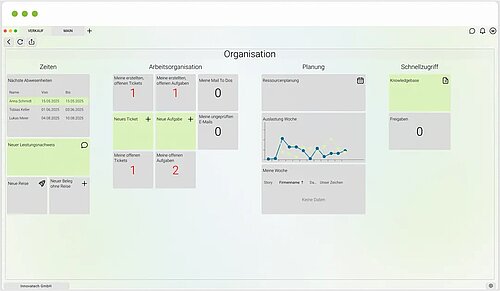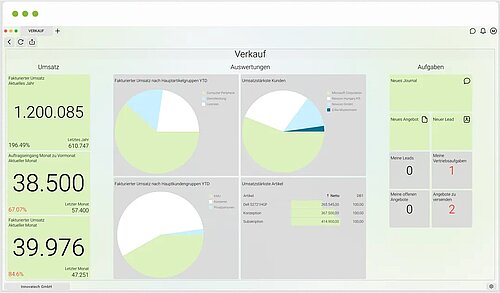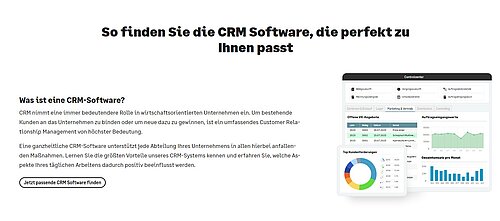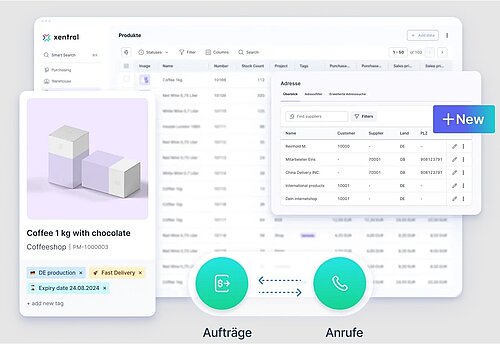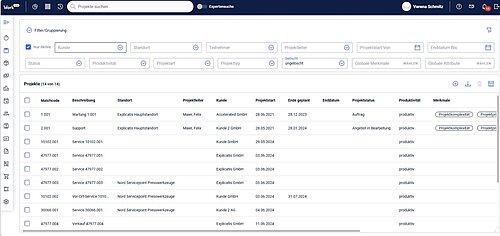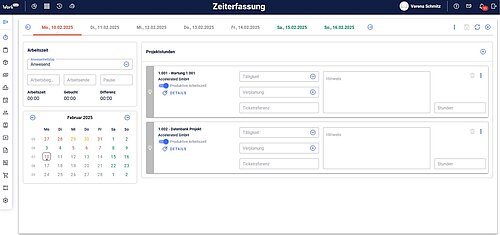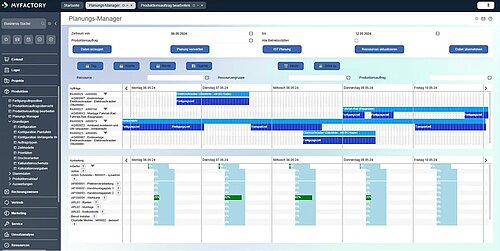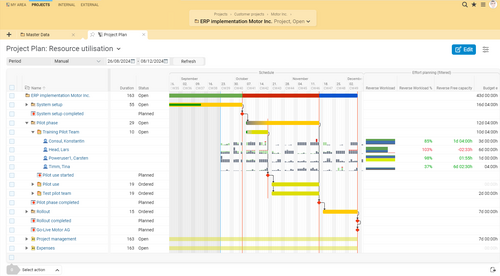08/22/2025 - Articles
ERP for service providers compared: An overview of the 10 best systems
For service providers, choosing the right ERP solution is more than just an IT decision – it determines how efficiently projects are managed, resources are utilised and customers are supported. Choosing the wrong solution means losing valuable time, transparency and, ultimately, revenue. In our ERP for service providers comparison, you will find out which ERP systems really move your service company forward, which functions make your everyday work easier and what you should definitely look out for when making your selection. Find the solution that really moves your company forward!
Why choosing the right ERP solution is crucial for service providers
In the digitized world of services, it is no longer enough to control processes manually or with individual solutions. Companies that work on a project basis, want to adapt flexibly to new requirements and at the same time use their resources efficiently need integrated systems that can do more than just accounting or time recording. Stand-alone solutions have had their day because they are too inefficient. This is where ERP systems come into play – tailor-made solutions that standardize operational processes, create transparency and make growth scalable.
For service providers—whether IT companies, agencies, consulting firms, or technical service providers—the requirements are often particularly complex. It's not just about classic functions such as invoicing or financial accounting, but also project management, time tracking, customer relationship management (CRM), resource planning, controlling, and ease of use for employees who are often not IT experts.
Warum sind ERP-Systeme gerade für Dienstleister besonders relevant?
Service companies are under pressure to deliver precise results with as little administrative effort as possible – whether in the form of customer projects, support services, campaigns, or consulting mandates. Revenue often depends directly on the time spent and the transparency of the project. A suitable ERP system provides support in:
the automated mapping of project and business processes
the seamless linking of time recording, resource planning, and billing
real-time controlling of projects and budgets
the integration of CRM and support functions
integration with existing tools and system landscapes
On the other hand, the “wrong” ERP can complicate processes, be expensive to maintain, and overwhelm employees—especially in smaller teams. Therefore, a structured selection process is essential.
ERP battle: comparing systems
Select two systems and start the comparison:
What service providers should look for when choosing an ERP system
The ideal ERP solution for a service company not only meets industry-specific requirements, but can also be flexibly adapted to individual needs. The following criteria should be the focus when making a selection:
Industry focus & specialization: Is the system designed for the requirements of project-based companies?
Modularity & scalability: Can functions be added or reduced as needed?
Project management & controlling: Are there integrated tools for planning, monitoring, and billing projects?
Time tracking: How easy is it to record working hours on a project-specific basis?
CRM & customer communication: How tightly is customer support integrated into the system?
User-friendliness: Is the system intuitive to use, even for non-technical users?
Cloud vs. on-premises: Which deployment model fits your IT strategy?
Interfaces & integrations: Can the ERP be integrated into existing system landscapes (e.g., accounting, support, BI)?
Support, training, and further development: How reliable is the provider in day-to-day collaboration?
Comparison of selected ERP systems for service providers
We present ten systems that are particularly suitable for service providers—each with its own focus and value proposition.
ERP for service providers ranking
1. Projektron BCS im ERP-Vergleich: Spezialisiert auf Dienstleister – projektstark, anpassbar, mit methodischer Tiefe
Projektron BCS is much more than just an ERP system—it is a comprehensive tool for planning, controlling, and evaluating complex projects in service-oriented companies. The web-based solution is primarily aimed at companies whose core business consists of implementing and coordinating projects: software developers, engineering firms, agencies, IT service providers, consultancies, and public contractors. Its modular structure, methodological depth, and high flexibility make BCS particularly attractive for companies that want to digitize more than just standard processes.
Browser-based, multi-client capable, individually configurable
Projektron BCS is completely web-based and runs either as an on-premises solution or from the German cloud – GDPR-compliant, ISO 27001-certified, and hosted in a high-security data center. Access is platform-independent via a browser, and the interface is intuitive and role-based. Particularly noteworthy: Almost every component can be individually configured – whether fields, workflows, rights, templates, or dashboards.
The multi-client capability makes the system ideal for corporate groups or organizations with multiple departments or customer groups that want to keep data clearly separate.
In-depth project management – methodical, well thought-out, and fully integrated
At the heart of Projektron BCS is project management – with a level of methodological depth that is rarely found in classic ERP systems. All aspects of the project life cycle are supported:
| Project structure planning (PSP) with milestones, work packages, and Gantt charts | |
| Resource planning across teams, roles, and calendars | |
| Task management with Kanban boards, checklists, notifications, and prioritization | |
| Time scheduling and recording at the task level, mobile or in the browser | |
| Calculation, budgeting, controlling, and forecasting for individual projects, customers, or company divisions | |
| Risk management, status reports, approval workflows, and change management are included as standard |
BCS supports classic, agile, and hybrid project management methods: Scrum, Kanban, PRINCE2, Wasserfall, Stage-Gate oder individuelle Vorgehensmodelle – alles integrierbar in die tägliche Arbeit.
Specialized ERP functions for service providers – developed with practical experience
Unlike many broad-based ERP systems, Projektron BCS was developed specifically for project-centered service companies – and this is evident in all areas:
| Service, quotation- and invoice creation are fully embedded in the project context | |
| Time tracking is possible down to the minute for each task—mobile, via app, or on the desktop | |
| Travel expense reporting, vacation, and absence management are closely linked to project and resource planning | |
| Helpdesk functions and support ticket system can be fully integrated into project management | |
| Customer access, role management, e-invoicing according to XRechnung/Peppol – all included | |
| QM functions and BPMN process management round off the business functionality | |
| Reporting functions for project controlling, resource utilization, sales development, ticket evaluation, SLA compliance, and much more |
Advantages at a glance: Project depth, adaptability, and practical relevance
| Expert-level project management: BCS was not simply expanded to include project functions – it was built around them. The result is a system that truly understands project processes. | |
| Customizable down to the last detail: From entry forms and workflows to the rights structure, BCS can be adapted to the structures and processes of any company – without the need for a developer. | |
| True end-to-end process mapping for service providers: From sales to quotations, projects, time recording, billing, controlling, and post-calculation, BCS covers the entire service process – without system breaks. | |
| Security and data protection at the highest level: Hosting in certified German data centers, no cloud dependency on US providers – ideal for data-sensitive industries such as healthcare, research, or public services. |
Discover Projektron BCS – the best ERP for service providers
Get a free online presentation to see the features that are most important for your company. Then start your 14-day free trial with no obligation—with all the features you want to explore.
Limitations? Almost only where you don't have projects
Projektron BCS is not a typical ERP system for retail companies or manufacturing industries with complex warehouse logistics, parts list management, or production planning. Service providers with these requirements will often find more suitable tools in classic ERP systems such as Haufe X360, SAP Business One, or Microsoft Dynamics.
However, for project-driven companies that want to systematically plan, execute, bill, and analyze their orders, there is hardly a solution that is as specialized, functionally deep, and flexible as Projektron BCS.
Support & implementation: Personal, German-speaking, close to the customer
Projektron BCS is implemented by our in-house consulting team – no external partners, no complex sales structure. Our experts know the system inside out and accompany customers from initial contact to go-live. Training courses, e-learning, video tutorials, free consultation hours, and personal contact persons ensure that the system is not only implemented but also understood and used.
Price structure: Transparent and investment-safe
BCS is licensed on a user basis – with a clear price structure, regardless of data volume or the number of projects. Thanks to its modular expandability, the system grows with the company without reaching its limits. Both rental and purchase models are possible, as is hosting by Projektron or on your own servers.
Conclusion Projektron BCS: The first choice for project-driven service providers
If you want to do more than just bill for projects and instead want to plan, manage, analyze, and optimize them, Projektron BCS is the ideal solution. In direct comparison with other broad-based cloud ERPs such as Haufe X360, BCS impresses with its methodological depth, outstanding adaptability, and uncompromising focus on project-centered processes.
For companies that work with demanding customers, want to deploy their teams efficiently, and manage projects successfully, BCS is more than just an ERP—it is a reflection of their entire organization and a strategic management tool.
Projektron BCS – the ERP solution for successful service providers
Whether you are an IT service provider, consulting firm, agency, or engineering office, Projektron BCS allows you to efficiently manage projects, services, and contracts—from planning to billing. Numerous awards, over 300 references, and real-life testimonials show why service providers across Europe rely on BCS. Visit our landing page for details on features, benefits, and practical examples.
Function overview, advantages, best practice: Projektron BCS for service providers
2. Haufe X360 in ERP comparison: Cloud convenience for service providers – modern, modular, with room for further development
ERP systems are now among the most important digital tools for companies looking to streamline, scale, or better integrate their processes. For service providers, who often work on a project basis, it is not only solid basic functionality that is important, but also functional depth, flexibility, and adaptability. Haufe X360 is a cloud-based ERP system designed specifically for small and medium-sized enterprises (SMEs) in Germany – modern, modular and with a comprehensive range of functions. But how well does it meet the requirements of project-oriented service companies?
Cloud-native architecture with a focus on SMEs
Haufe X360 is based on the internationally proven Acumatica ERP platform, but has been adapted and further developed for the German market. The system runs entirely in the cloud and offers a browser-based interface that works on all common end devices. A clear advantage for companies with
multiple locations
mobile field service
hybrid working models
The cloud architecture not only enables easy scaling, but also fast updates, access security, and integration with common third-party systems—for example, in the areas of CRM, e-commerce, or payment.
Broad portfolio of functions: From finance to production
Haufe X360 covers a wide range of core business processes. Its services range from financial accounting, inventory management, and warehouse management to CRM, purchasing, sales, e-commerce, project management, and service management. It even includes its own production planning (MRP) system, which is unusual for a cloud ERP in this segment.
Particularly relevant for service providers are:
Project accounting and controlling: Recorded services can be differentiated by customer, project, or activity and billed directly. Partial invoices and milestone invoices are also possible.
Resource management: Employees can record activities and times, which can later be invoiced or evaluated internally. Simple capacity overviews support resource planning.
CRM integration: The customer database can be linked directly to projects, quotes, and invoices, which simplifies sales and customer management.
Self-service portals: Customers can access information or submit support requests via portals, provided the module is activated.
Mobile use: The web interface is responsive, and an app for time tracking or travel expenses is available.
Strengths at a glance: Flexible, modular, and intuitive
Modular structure: Companies only choose the modules they really need, which ensures clarity and reduces unnecessary complexity. New modules can be added at any time.
Modern user interface: The design is clear and intuitive. Navigation is uncluttered, and modern web standards and search functions make everyday work easier – even for ERP beginners.
Strong focus on standardization: Haufe X360 is aimed at companies that want to cover as many processes as possible without implementing a separate specialized solution in each department. The idea: one central system for all core areas.
Securely hosted in Germany: Hosting and data storage are GDPR-compliant in German data centers – an important factor for many medium-sized customers.
Limitations: Functionality not always fully developed
Despite its broad functionality, Haufe X360 reaches certain limits in areas that require more in-depth or highly customizable processes. This is particularly true for service companies that place high demands on project management, resource planning, or company-specific workflows.
Project management: Standardized, but lacking methodological depth
Haufe X360 is well positioned for simple project structures. Effort estimates, budgeting, project times, and invoicing can be mapped.
However, anyone working with multiple parallel projects (multi-project management or portfolio management), agile methods, role and rights models, or Gantt charts will quickly encounter functional limitations. Features such as individual workflows, Kanban-based task management, or portfolio overviews are not (yet) included in the standard scope.
Service processes: Basic functions available, integration could be improved
The integrated service management is aimed more at technical service providers with clearly structured processes. Where complex resource planning, escalation management, or integration with ongoing projects are required, some manual adjustments or additional tools are necessary.
Reporting: Customizable, but sometimes complex to implement
The reporting functions are based on a powerful query tool, but sometimes require technical expertise for customized reports. Predefined standard reports are available, but are not always sufficient for more in-depth business analyses or project-specific KPIs.
Accounting: Strong, but with international legacy issues
Although adapted to German requirements, the origins of the US system are evident in some areas, such as document types, posting logic, and reporting. DATEV interfaces are available, but some manual adjustments are required.
Support & implementation: Partner concept with advantages and disadvantages
Haufe X360 is distributed exclusively through certified implementation and support partners. These partners take care of the entire rollout – from configuration and customization to ongoing support – and benefit from regular training, certifications, and a dedicated enablement team from Haufe.
Depending on the partner chosen, this can be a major advantage: For example, implementation partners report that the collaboration is structured and efficient, supported by reliable and competent support from Haufe. The partner concept also offers advantages such as local industry expertise and long-term support.
Some customers are critical of the following: Although documentation and training materials are available, they are not always complete or self-explanatory. As a result, the high degree of dependence on the implementation partner can limit independence in system use if additional guidance is lacking.
Price structure: Fairly calculated, but with hidden pitfalls
Pricing is based on a modular cloud model. Companies pay monthly per active user and per module used. This keeps the initial investment manageable, but as requirements and data volumes grow, monthly costs can rise sharply. Additional services such as training, customization, or support packages are often added. Smaller companies in particular should carefully consider what they need—and what they don't.
Conclusion Haufe X360: Modern cloud ERP solution with a clear target audience
Haufe X360 offers a robust and modern ERP platform for companies that want to digitally map standardized processes while leveraging the benefits of the cloud. The solution scores with its modular structure, broad functionality, and technical modernity—especially for companies in retail, manufacturing, or with clearly defined service processes.
However, for service companies with complex, often customized project requirements, agile structures, or process-oriented control, the solution is not (yet) deep enough in all areas. In such cases, the targeted use of specialized systems that offer methodological depth, flexible process design, and consistent project orientation can be useful – for example, for agencies, consultancies, or technical service providers with their own development department.
Those who are willing to embrace the partner concept, accept a certain degree of standardization, and primarily want to benefit from the advantages of a modular cloud ERP will find Haufe X360 to be a powerful solution with great potential.
3. ZEP in ERP comparison: Specialized in time tracking – streamlined, focused, with a clear target audience
ZEP (“Time Tracking for Projects”) is a lean, cloud-based solution that focuses on what many service companies need every day: fast, legally compliant, and accurate time tracking. Designed for project-based teams, freelancers, and smaller service providers with a focus on project billing, ZEP offers exactly the features needed for reliable time tracking, billing, and evaluation—nothing more, nothing less.
Quick to get started, intuitive to use, no training required
ZEP runs entirely in the cloud, with no installation required – simply register, log in, and get started. The interface is clearly structured and easy to use, even for inexperienced users. Employees record their times via browser, app, or time clock interface; project managers then evaluate the data, assign services, and export them for billing.
Thanks to automatic updates and cloud-based infrastructure, ZEP is maintenance-free—ideal for companies that do not operate their own IT and prefer lean processes.
Time tracking as a core competency—and more
ZEP's focus is clearly on time tracking in projects. Depending on the module selected, additional functions are available, such as:
Project structure and budget planning
Vacation and absence management
Travel expense reporting
Invoicing and quote management
Resource evaluation, capacity planning, customer management
Compliance with legal requirements (e.g., working time guidelines, GoBD)
One highlight is legal compliance: ZEP offers functions for meeting legal requirements for time tracking, including daily target/actual comparisons, complete documentation, and configurable verification rules. Companies with compliance requirements will find a reliable foundation here.
Ideal for smaller service providers, consultancies, and agencies
ZEP is particularly strong where a company...
has few employees who book time on projects
bills services based on time spent
prefers clear structures without complex workflows
wants to be productive quickly without a major system rollout
Typical users are consultancies, agencies, IT freelancers, law firms, or small service providers in the technical field. ZEP is also used in the public sector in isolated cases, especially where little customization is required.
Modularly expandable, but functionally focused
ZEP has a modular structure: basic functions can be expanded with additional modules, for example for invoicing, travel expenses, project controlling, or vacation management. This makes the solution flexible – but also clearly limited. Functions such as multi-level workflows, risk or knowledge management, portfolio planning, customer portals, or agile methods (Scrum, Kanban) are either completely missing or only available in a very basic form.
Unlike ERP systems such as Projektron BCS or Haufe X360, there is no deep integration of project management methods – projects exist as time tracking and billing contexts, not as living planning and control units. Individual workflows, role permissions, or specific reports are also hardly customizable.
Strengths of ZEP at a glance:
Quick start, easy to use: Ready to use immediately without training, ideal for small teams or sole traders.
Legal certainty for time tracking: GDPR-compliant, GoBD-secure, working time-compliant – a plus for audits and documentation requirements.
Predictable costs and cloud-based operation: No infrastructure required, updates and data backup included.
Functional focus on time tracking & invoicing: If that's what you're looking for – without any extra features – ZEP is the right choice.
Limitations: not a complete ERP system, no project methodology
ZEP is not a full-fledged ERP system, but a specialized solution for time and project tracking, supplemented by basic features such as invoicing and vacation management.
For companies with more complex requirements – e.g., in the areas of project planning, workflows, controlling, or method integration – ZEP quickly reaches its limits.
The need to switch to a more comprehensive system becomes particularly apparent when multiple teams are working on projects in parallel, resources need to be planned on a weekly or monthly basis, risks need to be assessed, quotes need to be calculated, and projects need to be systematically managed.
ZEP conclusion: Strong in its niche, ideal for entry-level users – but not scalable for every scenario.
ZEP impresses with a focused approach that concentrates on the core processes of small service providers: recording time, assigning projects, and billing. Those who need exactly that – without overhead – will find ZEP to be a reliable, tried-and-tested, and affordable solution. However, for growing companies, project-driven SMEs, or service providers with high control requirements (such as IT development, engineering, or research), ZEP remains an entry-level solution rather than a long-term solution.
4. weclapp in ERP comparison: User-friendly, solid – but with limitations in project management
weclapp is one of the best-known cloud-based ERP solutions from Germany and is primarily aimed at small and medium-sized enterprises. The software places great emphasis on user-friendliness and rapid deployment. Without the need for complex IT infrastructure, companies can get started with just a few clicks and receive a system that seamlessly connects sales, customer management, and commercial processes.
This makes weclapp particularly attractive for agencies, IT service providers, and smaller consulting firms—anywhere where services are clearly structured and standard processes dominate. The cloud-based architecture allows access from anywhere, and the modern interface is clear and self-explanatory.
Solid basic functions—especially for CRM and billing
A central element of weclapp is the integrated CRM, which bundles customer contacts, email communication, tasks, and sales opportunities in one system. From the initial quote to order processing and invoicing, many typical business processes can be mapped end-to-end. Recurring services and subscriptions are also reliably supported.
For many smaller service providers, this is a decisive advantage: they get a system that combines classic ERP functions with customer and sales management suitable for everyday use – without additional tools or interfaces.
Project management: Functional, but not very methodical
However, when it comes to more complex project requirements, weclapp reaches its limits. Although projects can be created, budgets can be set, and times can be booked for tasks, there is a lack of methodological depth.
Project management in weclapp remains more administrative than strategic: Gantt charts, agile methods such as Scrum or Kanban, portfolio management, role and rights management at project level, and individual workflows are all missing.
The range of functions is usually sufficient for smaller companies or simple service projects. However, those who work with parallel projects, complex resource plans, or methodological requirements will not find the necessary tools in weclapp—specialized solutions such as Projektron BCS offer significantly more depth in this area.
Service processes and support functions with basic scope
Although weclapp offers a simple ticket system for managing customer inquiries, real service processes – such as escalation logic, resource planning, or links to project planning – are only available in a rudimentary form. This range of functions is rarely sufficient for organizations with a strong project service business or technical support.
Advantages in terms of usability – but little scope for customization
A major advantage is its intuitive usability: weclapp aims to enable users to quickly find their way around without training. At the same time, this consistent standardization is also a weakness, as customization to specific processes, individual fields, or role-based control is only possible to a limited extent.
In addition, as a cloud solution, weclapp is offered exclusively via its own data center in Germany. This is an advantage for many companies from a data protection perspective, but it also reduces the integration options with on-premise systems or third-party applications that require a more open API.
Weclapp conclusion: Easy to get started – but with limits to growth
weclapp is a modern ERP software for small businesses that value ease of use, solid CRM, and quick implementation. The solution is well suited for classic service processes with manageable project volumes. It combines many basic modules in one system, enabling a digital entry point without major hurdles.
However, the functions are not sufficient for growth-oriented service companies with complex projects, different planning methods, or high customization requirements. Compared to an ERP system with a project focus, weclapp remains too superficial in key areas. Those who want to grow in the long term, manage projects strategically and at the same time establish solid processes in accounting, service and controlling will find more comprehensive, professional and expandable solutions.
5. Odoo in ERP comparison: Extremely flexible, strong internationally – but not ideal for every company
Odoo is an open-source ERP system that, with over 30 main modules and thousands of community extensions, is one of the most flexible business platforms worldwide. Originally developed in Belgium, it is now used internationally, especially by start-ups, medium-sized companies with a high level of digital affinity, and companies looking for software solutions tailored precisely to their needs.
The idea behind Odoo is that companies can customize their ERP environment like a building block system. Modules for accounting, sales, human resources, project management, warehousing, help desk, and e-commerce can be combined as desired. Odoo can be operated as a cloud solution (Odoo Online) or fully self-hosted (Odoo Community), making it particularly attractive for internationally active or data-sovereign organizations.
Wide range of functions – with great potential for process mapping
Odoo is particularly strong in its breadth: from marketing, CRM, and time tracking to HR, accounting, and service processes, it can cover almost every area of business. With smart configuration and the right combination of apps, you can create an extremely powerful ERP system—especially if you have technical resources in-house or an implementation partner at your side.
Odoo's strength lies not only in its scope, but also in the depth of many of its modules. Financial accounting offers functions such as SEPA payments, dunning, and multi-currency capability. Project management allows time entries, dependencies, Gantt charts, and even agile methods – albeit in some cases only after specific configuration.
Flexibility requires expertise – configuration is not a sure-fire success
The downside of this flexibility is that without in-depth technical knowledge or the support of an experienced service provider, Odoo is only partially operational. Even selecting and coordinating the modules requires conceptual work. Configuration errors can quickly lead to functional gaps or inconsistent data. Project business in particular requires clean workflows, precise role permissions, and a well-thought-out structure – and this is precisely where Odoo often lacks the clear lines that specialized systems such as Projektron BCS offer as standard.
The issue of updates should not be underestimated either: Odoo is developing rapidly, but not all modules are compatible with every version. Those who use many community extensions must expect technical effort when major updates are released. Companies that depend on stability and long-term maintainability should weigh this carefully.
Strengths in integration – weaknesses in methodological management
Odoo scores particularly well when a large number of processes need to be integrated, such as sales, project management, and warehousing. In such cases, data sources can be elegantly linked. However, there is a limited methodological focus in project management. Although there are tools for agile sprints, resource planning, and task management, more in-depth functions such as project portfolio management, earned value analysis, sophisticated controlling tools, and comprehensive role and rights concepts at the project level are lacking.
This shows that Odoo offers a great deal of flexibility and breadth, but no consistent methodology. This may be sufficient for agencies or production-oriented companies, but anyone who wants to map professional project structures and scale them in the long term will encounter functional and organizational limitations.
International community – but no real support from a single source
Another difference from traditional ERP providers is that Odoo is supported by a large international community. While this has advantages in terms of innovation and expandability, many companies lack a central point of contact with a deep understanding of German SMEs. There are certified partners, but their quality and industry knowledge vary greatly.
In regulated or high-security environments (e.g., healthcare, public administration, research institutions), there is often a lack of references or evidence of compliance with standards such as ISO 27001, TISAX, or GoBD – aspects that are an integral part of specialized solutions such as Projektron BCS.
Conclusion Odoo: Ideal for tech-savvy companies – but not the most secure choice for everyone
Odoo is an impressively versatile platform with enormous potential – especially for companies with their own IT team, a high level of configuration readiness, and the requirement to map their processes precisely in digital form. Those who master its complexity will gain a powerful system that goes far beyond classic ERP functions. But this freedom also comes with responsibility. For service companies that require clearly structured project methods, have high demands on reliability, support, and information security, or must comply with regulatory requirements, Odoo is not always the best choice.
6. Munixo in ERP comparison: A customizable ERP platform for medium-sized businesses
Munixo, the ERP platform from Garching-based provider Novicon, is aimed at medium-sized companies that value integrated business processes and individual configurability. Unlike many traditional ERP systems, Munixo is not designed as a rigid complete system, but as a flexibly expandable platform concept. Companies can put together their own system from various modules – from core ERP functions to CRM, project management, HR, and DMS to business intelligence and controlling.
This modular architecture enables a high degree of customization for different areas of the company. Whether you are a service provider, a manufacturing SME, or an organization with industry-specific requirements, Munixo can be configured to suit your specific processes. Not only are individual functions adapted, but the user interfaces, dashboards, and data models are also tailored to the company's way of working. The platform is available both as a cloud solution via German data centers and on-premise, providing even data-sensitive industries with a flexible basis for their digital process landscape.
Customizability without programming knowledge
A key feature of Munixo is the high degree of customization options – and all without in-depth programming knowledge. Using the “Design Center,” masks, forms, workflows, and dashboards can be largely designed in-house. This allows companies to not only digitize their processes, but also continuously develop them without having to rely on external developers every time. The system allows different user roles to be assigned specific rights and customized interfaces, so that employees only see the information and functions that are relevant to them.
Technically savvy users or IT departments also have the option of using Lua scripts, a REST API, and plug-in structures to achieve even deeper integration. This makes Munixo not just an ERP system in the traditional sense, but rather a platform for digital business management—with a clear focus on adaptability and updatability. At the same time, the system remains stable because it is based on a modern three-layer architecture using the .NET framework.
Project management and service control
For project-oriented service companies, Munixo offers a particularly interesting combination of ERP logic and project control. The software enables the end-to-end planning, execution, and billing of projects, including:
Time recording
Task management
Resource management
Ticketing
Recurring services, support contracts, and managed services can also be clearly mapped, including budget monitoring and performance reports.
Munixo emphasizes close integration between project and company management: projects are not treated as separate entities, but are deeply integrated into the rest of the company's logic.
For example, sales opportunities from CRM can be transferred directly to projects, and project costs flow seamlessly into financial accounting. This end-to-end transparency makes Munixo particularly interesting for companies where project work, customer relationships, and commercial processes are closely intertwined.
Business intelligence directly integrated
Another advantage of Munixo is its integrated business intelligence system. Instead of having to connect external BI tools, the platform itself offers extensive analysis and reporting functions. Companies can generate pivot tables, dashboards, PDF reports, and even table analyses directly from existing data. The reports can be created not only statically, but also interactively – for example, with drilldowns, filters, or live data tiles on the start screen.
This integrated BI expertise enables managers to track key figures from a wide range of areas – from sales and project performance to finance and capacity utilization – in a single system. At the same time, the effort required for data exports and manual evaluations is significantly reduced. For companies that work in a data-driven manner or require precise reporting, Munixo offers a powerful tool – without any additional license costs for third-party systems.
Customer experiences and application scenarios
Feedback from Munixo customers shows that medium-sized companies with different departments benefit particularly from the system. IT service providers use the integrated ticket system for customer support, while engineering firms use the project area with billable time tracking. Production-related companies appreciate the connection between order processing, warehousing, and CRM. Munixo is also used in research and development, for example by organizations that have to meet complex reporting requirements and budget targets.
Many users see the modular entry point as an advantage: companies can start with core functionality—such as project management and time tracking—and gradually add further modules. The support provided by Novicon is generally described as reliable and solution-oriented. In some areas, the user guidance and the quality of the documentation could be improved, especially when highly customized processes need to be implemented.
Pricing model and investment framework
Munixo is not one of the cheapest ERP solutions, but it offers solid value for money – especially for companies with multiple departments or specific control requirements. The entry-level package, “ERP Starter,” costs around €9,900 one-time and €990 per month for five users. It already includes key functions such as CRM, project management, time tracking, DATEV export, and financial accounting. More comprehensive packages, such as “ERP Service,” start at around €14,900 and include additional functions such as intercompany, XRechnung, REST API, and DMS.
The prices may seem high at first glance, but they are quite competitive compared to individually programmed ERP systems or complex industry solutions. Companies that work with Munixo on a long-term basis and set themselves up well in terms of configuration benefit from continuous development, functional breadth, and low follow-up costs for expansions.
Conclusion Munixo: Flexibility for growing medium-sized companies with complex processes
Munixo offers a powerful solution for medium-sized companies that are not looking for an off-the-shelf ERP system, but want to actively shape their processes. Its modular structure, configurable interface, and deep integration of various functional areas make Munixo a serious alternative to larger platforms such as SAP Business One or Microsoft Dynamics—with a special focus on suitability for medium-sized businesses and user autonomy.
However, Munixo may be overkill for small businesses with a lean process model or highly standardized requirements. But if you want to structure complexity cleanly, connect departments, and respond flexibly to change, Munixo is a future-proof and adaptable platform for digitizing your entire company.
7. Sage in ERP comparison: Proven business software with a focus on accounting and small and medium-sized businesses
Sage is one of the world's largest providers of business software for small and medium-sized enterprises. The British company has established itself in the German market with a range of products that are particularly well known among retail companies, service providers, and skilled trades. The spectrum ranges from lean entry-level solutions for financial accounting to full-fledged ERP systems with warehouse management, production, and human resources management.
In Germany, Sage 100 is one of the most widely used ERP products. It offers a modular structure that can be used to map commercial processes and operational workflows – from merchandise management and CRM to payroll accounting and project management. Sage combines a certain degree of standardization with adaptability via its own customizing framework. This provides companies with a solution that works reliably and can also grow with them.
Core functions and typical areas of application
Sage 100 covers the typical requirements of medium-sized businesses: order processing, purchasing, warehousing, production, financial accounting, cost accounting, and human resources. The software is particularly strong in the area of accounting, where Sage benefits from decades of experience with software for tax advisors, accountants, and SMEs.
The integration of DATEV exports, GoBD compliance, dunning, and ELSTER connection is seamless and included in the basic package. Sage also proves its performance in companies with high document volumes or complex pricing structures in sales. Various add-on modules allow for the integration of variant configuration, serial number management, and batch tracking, for example.
For manufacturing companies, there is a production module that maps production orders, parts lists, and capacity planning. The functional depth is solid overall, although some areas—such as project management and resource planning—are kept rather simple.
Customizability via AppDesigner and partner solutions
What sets Sage 100 apart from many standard solutions is its integrated AppDesigner. This allows masks, input fields, menu structures, and even logic within the system to be customized without changing the core system. This means that customer-specific adjustments are retained even after updates. This option is primarily used by IT-savvy companies or Sage partners to implement departmental requirements as precisely as possible.
Sage also pursues a strong partner approach. Numerous system houses in Germany distribute, configure, and support the software. In addition, there is a wide range of certified extensions—from DMS systems and BI tools to industry solutions for wholesale, skilled trades, and project-based services, for example. Those who need to delve deeper into specific special processes will often find suitable solutions through these partners.
Cloud or on-premise: flexible operating models
One advantage of Sage is the choice between different deployment models. While smaller products such as Sage 50 and Sage Business Cloud are offered purely as cloud-based solutions, Sage 100 can be run locally on your own servers or via hosting partners in German data centers. Sage's cloud strategy has been significantly advanced in recent years, but remains rather conservative compared to younger cloud ERP providers. Updates are not automatic and must be actively installed, depending on the hosting provider.
For many medium-sized companies, this can be an advantage: they retain control over their system, their data, and their infrastructure. At the same time, Sage offers options for connecting external systems via modern interfaces such as REST API and web services. Office 365 integrations, automatic document recognition, and mobile functions are also available depending on the version, although this technological modernity has not been consistently implemented across the board.
Customer experiences and real-world use
Sage customers particularly praise the stability of the system, the wide availability of service providers, and the solid mapping of business processes. Many users feel particularly well supported in the financial area. The learning curve is moderate, partly because many processes follow the familiar structure of classic merchandise management or accounting systems. However, there are also reports that some functions appear outdated or cannot compete with more modern cloud ERPs such as weclapp or Odoo in terms of usability.
In practice, satisfaction often depends heavily on the supporting partner: those who rely on a competent system house with industry experience can make good use of the advantages of Sage. On the other hand, those who start without intensive customization may encounter limitations, for example in mobile use, reporting, or more complex process chains across multiple modules.
Pricing model and economic classification
Sage's cost structure is relatively traditional: licenses are charged per user and module, plus implementation costs, customization, and, if necessary, hosting costs. The entry-level package for Sage 100 usually starts at around €6,000–10,000 in license costs plus monthly maintenance and update fees. Depending on the partner, implementation costs of between €10,000 and €25,000 can be added, depending on the complexity and scope of the modules.
For companies that already have experience with ERP implementations or are specifically looking for a financially strong solution with a broad partner market, Sage offers good value for money. However, those who want to get started as quickly and leanly as possible without much partner commitment will often find modern SaaS systems easier to access.
Conclusion Sage: A solid ERP classic with particular strengths in accounting
Sage is an established ERP option for medium-sized businesses that scores particularly well in accounting, inventory management, and financial processes. Its long-standing market presence, broad partner network, and flexible customizability make it a proven solution for companies with established structures and individual requirements. Sage's strengths lie particularly in areas where stable processes, legally compliant accounting, and long system lifetimes are required.
Sage is less suitable for companies that are looking for a consistently modern, intuitive cloud platform or want to work agilely with lean project teams. Sage also lags behind in terms of user interface and innovation speed. Nevertheless, for many medium-sized companies that need security, reliability, and customized process mapping, Sage remains a serious ERP candidate with a solid foundation.
8. Xentral ERP in practice: Fast ERP for e-commerce and start-ups – with hurdles for service providers
Xentral is an ERP system “Made in Germany” that scores highly thanks to its speed, ease of use, and cloud architecture. Originally developed for the e-commerce sector, Xentral is now aimed at small to medium-sized companies in a wide range of industries, from online retailers and manufacturers to agencies. The system promises a central solution for inventory management, logistics, finance, project management, and CRM.
But how well does Xentral perform in the everyday life of service companies? And where do its strengths and weaknesses lie in comparison to specialized solutions such as Projektron BCS?
Modern, fast, and intuitive – the advantages of Xentral
Xentral impresses above all with its clear focus on lean processes and intuitive user guidance. The cloud application can be used entirely in a browser and can be set up relatively quickly – in many cases within a few days. Young companies and startups that need a system that is available quickly benefit in particular from the uncomplicated setup and modular expandability.
Particularly noteworthy is the strong focus on retail and logistics processes. Integrated warehouse management, connections to shop systems such as Shopify, WooCommerce, and Amazon, and automations in order processing make Xentral an attractive solution for companies with a focus on e-commerce.
The interface also looks clean and modern. Many functions can be customized or expanded with a single click, and a growing number of integrations (e.g., DATEV, Lexoffice, DHL, Google Workspace) support the seamless connection of existing tools.
Project management and services: Limited applicability
Xentral performs less well when companies want to manage more complex services or projects. Although there are modules for time tracking, task management, and rudimentary project controlling, these are more suited to small agencies or internal tasks in terms of scope and depth.
Structured project planning with Gantt charts, milestone tracking, capacity balancing, or agile methods (Scrum, Kanban) are largely absent. Role and rights management is also less granular than in systems such as Projektron BCS, which were designed specifically for project-driven organizations.
Service companies with multiple parallel projects, internal and external resources, or industry-specific requirements therefore quickly reach functional limits with Xentral—especially if they want to seamlessly integrate project billing, quoting, and controlling.
Accounting and reporting: Integrated, but limited
When it comes to financial accounting, Xentral offers an integrated solution with invoicing, dunning, sales statistics, and a DATEV interface. This is sufficient for many smaller companies, especially if they use external tax advice.
However, for more demanding requirements (e.g., advanced cost center accounting, balancing, cash flow planning), supplementary tools or third-party connections are recommended. Reporting is also clear, but limited in terms of customization. Custom reports or consistent KPIs for project-related controlling must either be generated externally or programmed individually.
In comparison, solutions such as Projektron BCS offer significantly more sophisticated reporting that is tailored to the needs of project-oriented companies.
Support, training, and community: Small but dedicated
Xentral relies heavily on online support, help desk articles, tutorials, and a community of partners and users. This works well as long as the requirements remain within the standard range. However, personal support with in-depth product knowledge or complex customization can be time-consuming or costly.
Implementation is usually carried out by certified partners. Here, too, a lot depends on the quality of the service provider – a risk that is less likely to arise with direct support from a single source (such as Projektron).
Price structure: Fair, but with potential additional costs
Xentral offers a modular pricing model based on SaaS (Software-as-a-Service). Monthly costs start at around €199 per month for small teams, but scale quickly with the number of users, modules, and integrations required. One-time costs for implementation, training, and partner services may also apply.
What appears inexpensive at first glance can increase significantly in the medium term, depending on the size of the company and its needs. More complex companies with many users or special requirements should calculate carefully whether Xentral is economical in the long term – or whether a more comprehensive system such as Projektron BCS with stable processes and predictable costs is the better choice.
Xentral conclusion: Quick to get started – but not suitable for all industries
Xentral is a dynamic, modern ERP solution for startups, e-commerce companies, and smaller teams with clearly structured processes. The system offers a quick and flexible entry into the world of ERP, particularly when it comes to combining inventory management, order processing, and logistics.
However, Xentral reaches its functional limits for service companies with demanding project business, individual resource planning, or process-oriented organization. The system is not designed for project-driven control, but rather for standardization and automation of simple business processes.
Those who manage complex projects, are responsible for budgets, have to combine multiple teams or methods, and value in-depth controlling, reliable reports, and high data depth will be much better off with specialized solutions.
9. Custable in ERP comparison: Modern tool for small service providers – with clear limits on growth
Custable is an ERP solution that has emerged in recent years and deliberately positions itself against overloaded, cumbersome systems. The cloud software is aimed at smaller teams, agencies, and service providers who want to manage their projects, times, invoices, and customer processes centrally, efficiently, and without unnecessary ballast.
But how much ERP is really in Custable? Who is the system suitable for – and when does it start to feel cramped?
Focus on simplicity: Custable for small teams and agencies
Custable focuses on a minimalist, user-centered design. The interface is clearly structured, the most important functions are quickly accessible, and operation requires little training. The goal: service companies—especially those in the creative and consulting industries—should be able to get started as quickly as possible and keep an eye on all core processes.
The standard system primarily covers the following areas: project creation, time tracking, task management, customer and contact database, quote creation, invoicing, and simple reports. These features work well together, making the tool feel streamlined and efficient. Time tracking and accounting especially benefit from the consistent logic and intuitive operation.
Custable deliberately positions itself as a lightweight ERP for small and medium-sized businesses – with no training required, no lengthy implementation and short decision-making processes. Anyone who has previously worked with Excel, timesheets or several small tools will quickly become more productive with Custable.
Project success in sight – but only limited control
Despite its strength in simple project management, Custable remains limited in depth. There is no classic project planning with timelines, milestones, or resource allocation. Budget planning and forecasting are also only possible via workarounds, if at all.
This is not a problem for individuals and small teams where one person takes on multiple roles. However, anyone who has to manage larger projects with multiple participants, work packages, dependencies, and deadlines will eventually find Custable too simplistic.
Agile methods such as Scrum or Kanban cannot be directly mapped in the system either. Tasks can be assigned to lists and projects, but boards, backlogs, or sprints are nowhere to be found. There are also no integrations with tools such as Jira, GitHub, or other systems that are frequently used in technical service projects.
Billing and accounting: Functional, but no substitute for financial accounting systems
One plus point: Custable allows quotes and invoices to be created directly from within the project context, including time entries. A simple dunning process is also included, as is an overview of open items.
Nevertheless, one thing is clear: Custable is not suitable for complete financial accounting. There is no DATEV export or integration with common accounting programs such as Lexoffice or SevDesk. Tax advisors must obtain their data by other means, which can complicate the process in the long run.
There is also no clear separation of revenues, cost centers, or accounting periods. Custable is therefore only of limited use for companies that work with profit and loss statements or controlling figures.
Scalability: limitations in terms of teams, processes, and integrations
Custable was clearly designed for small to medium-sized companies. The interface is not designed for large numbers of users, and rights and role concepts are kept very simple. There are hardly any interfaces to third-party systems, and individual extensions or APIs are also missing so far.
This means that anyone who uses Custable has to work with what the system offers. Customization is hardly possible, and automation is only possible within very narrow limits. For startups or small agencies that need a simple, functioning system in a short period of time, this is perfectly fine. For growing organizations that want to connect different teams, processes, and systems, Custable is too limited in the long term.
Price and support: Fair, but with a DIY feel
Custable is very affordable: Entry-level costs start at less than €20 per user per month, depending on the package. A free trial period is also available. This makes the solution attractive for cost-conscious founders and start-ups.
When it comes to support, Custable relies heavily on self-service: help articles, email support, and a simple onboarding process guide users through the most important steps. Personal advice or individual training is only available on request – and usually at an additional cost. Those who are well organized will be able to manage on their own. However, those who need a complex setup or external support are better served by other providers.
Custable conclusion: suitable for beginners, but not for complex projects
Custable is a user-friendly, modern ERP system for small agencies, freelancers, and project-oriented startups that want to professionalize their processes without a lot of IT effort. The software impresses with its ease of use, good integration of core functions, and a very fair price-performance ratio.
However, as requirements increase – for example, due to larger project volumes, parallel projects, demanding customers, or differentiated internal processes – Custable becomes too limited. The lack of functionality, hardly any integrations, and limited control options make it clear that the system is only suitable for growth to a limited extent.
Anyone who already coordinates multiple teams, manages external and internal resources, implements industry-specific requirements, or performs in-depth controlling will sooner or later reach the limits of Custable.
10. Myfactory in ERP comparison: Flexible cloud ERP solution with ERP core – but more suited to traditional SMEs than project-oriented companies
Myfactory is one of the established cloud ERP systems in German-speaking countries. Based in Munich, the company offers a modular, fully web-based solution that is particularly aimed at small and medium-sized companies in the retail, manufacturing, and service sectors. With around 20 years of market experience and a network of partners behind it, myfactory is a solid, reliable ERP choice, especially for classic business models – albeit with limitations in project-oriented work.
Flexible, modular, web-based: the strengths at a glance
The biggest advantage of myfactory is its flexibility. The system covers all classic ERP areas: merchandise management, financial accounting, CRM, production, warehousing, e-commerce, DMS, and even POS (point of sale). Thanks to its modular structure, the system can be tailored to fit your needs and expanded at a later date.
All modules are completely web-based, making myfactory a true cloud solution – unlike many competitors who offer hybrid models or only make parts of the system available online. The responsive design allows it to be used on tablets and smartphones without the need for an app.
Another advantage is that myfactory is sold both directly and through certified partners who can provide customization, support, and implementation. This is an important plus, especially for companies with specific requirements or a lack of IT infrastructure.
Classic ERP with a clear structure – ideal for retail and manufacturing
Myfactory has clearly evolved from the classic ERP environment. The structure is logical, the modules are coordinated, and the processes are solidly mapped. Anyone who works with suppliers and customers, manages articles, controls the flow of goods, writes quotations, and issues invoices will find a reliable solution here.
Companies in wholesale and retail, technical sales, and manufacturing benefit in particular from the sophisticated merchandise management, integrated warehouse management, and finance module with DATEV interface. Multilingual items, variant management, serial numbers, and supply chains can also be mapped in detail.
In these areas, myfactory impresses with a high degree of practicality, stability, and scalability—especially with the ability to centrally manage multiple clients or branches.
Limitations in project management and agile working
However, myfactory is less strong when it comes to project management. Although services, deliverables, and working hours can be bundled into projects, there is no real project structuring with milestones, dependencies, Gantt charts, or agile boards.
Resource planning, personnel allocation, and project-related budgets are also only available in a rudimentary form or via workarounds. This makes myfactory less attractive for companies that not only want to bill projects but also actively control and manage them, for example in IT, engineering, or consulting.
Where tools such as Projektron BCS score points with their methodological depth, project-centric interface, and comprehensive controlling, myfactory remains too generic.
In addition, myfactory lacks direct connections to common project tools such as Jira, Trello, or Git, which makes integration into agile software development or creative processes difficult.
User guidance, interface, and customization
The user interface of myfactory is functional, but its design is more functional than modern. Navigation is via classic menus, and the operating logic is strongly based on established ERP standards – which experienced ERP users appreciate, but which requires some training for beginners.
Customization is possible in principle, but in many cases only by certified partners. There is an open API, but the documentation is somewhat sparse. The form designer, which can be used to customize documents, also requires technical knowledge. This is not a problem for companies with their own IT department, but it can be a hurdle for small teams without ERP experience.
Price structure and target group
Myfactory is priced for traditional small and medium-sized businesses. Costs vary depending on the number of modules and users, but usually start at around €50–80 per user per month, plus one-time setup and, if applicable, hosting costs (if you don't use myfactory's own cloud server). There is no free package, but a free demo and trial version are available through partners.
The target group is small to medium-sized companies with clear structures that are looking for a solid ERP with a high level of functionality for classic business processes – but not start-ups, creative agencies or project-driven service providers with highly iterative, cross-team processes.
Myfactory conclusion: Reliable cloud ERP for traditional SMEs – not designed for project management
Myfactory is a well-designed, tried-and-tested ERP solution that impresses above all with its modular structure, comprehensive web technology, and solid functionality. Companies in the retail, manufacturing, and traditional service sectors will find a stable platform here that reliably maps all core processes. However, those who need intensive project management, agile methods, resource utilization, or team-oriented work will find myfactory's capabilities limited.
Weitere ERP-Systeme für Dienstleister im Überblick: Honorable Mentions
In addition to the ERP solutions already compared in detail, such as Projektron BCS, Haufe X360, ZEP, Odoo, weclapp, Xentral, Myfactory, Custable, Sage, and Munxio, there are numerous other systems on the market that also attempt to support project-oriented service providers with an integrated solution for organization, planning, and billing. Some of these systems are aimed at niche markets, others deliberately focus on general applicability, and some offer interesting approaches without quite reaching the top in terms of project management functionality.
Here is a commented overview of other providers that deserve an honorable mention and may be worth a closer look in the future.
Uniconta – Modern cloud technology with a focus on accounting
Uniconta originally comes from Denmark and is also actively marketed in German-speaking countries. It is a completely cloud-based ERP system that does not require local installation and includes classic ERP modules such as accounting, warehousing, sales, and purchasing.
The focus is strongly on financial accounting and less on methodical project management. Although projects can be managed and billed, tools for agile working methods, resource planning, or milestone tracking are largely missing. For companies with highly accounting-driven processes, Uniconta can be an affordable, modern option – but for project-driven service providers, the solution is too superficial.
Teamspace – Integrated working with a focus on small teams
Teamspace promises “Teamwork. Projects. ERP – all in one system.” Behind this is an approach that is primarily designed for smaller companies with flat structures. The software combines time tracking, task management, project budgeting, customer management, and invoicing in one system – similar to Vertec, but with a stronger focus on collaboration and ease of use.
This is attractive for agencies, freelancers, or small consulting teams with a clear distribution of tasks. However, the solution lags significantly behind established ERP systems in terms of depth and customizability. Interfaces and reporting functions also appear limited. Those who want to digitize simple workflows will be in good hands here, but those who need to manage large teams or complex project landscapes will quickly reach their limits.
Scopevisio – Data protection-compliant cloud ERP with a strong finance module
Scopevisio positions itself as a cloud ERP from Germany with a focus on data protection and compliance. The solution covers all classic ERP areas – from CRM and accounting to document management and HR. The system is particularly strong in financial accounting and business intelligence.
The integrated project module offers basic functions for service providers, including task planning, budget tracking, and time recording. However, visualization options (e.g., Gantt charts), agile boards, and resource management are missing. The interface also appears cluttered in places. Scopevisio is therefore more of an all-round ERP with a commercial focus than a specialist for projects.
microtech büro+ – ERP for retail and manufacturing with limited project depth
Microtech is best known for its büro+ solution, an ERP system that is strongly geared toward small and medium-sized companies with clear processes in retail, shipping, or contract manufacturing. Its strengths lie in merchandise management, order management, and process automation.
Although a project module exists, it is very rudimentary and limited to assigning services to customers or internal processes. For IT service providers, agencies, or consultancies, it lacks the methodological depth offered by other systems. Microtech scores where processes are highly standardized – not in complex project structures.
proALPHA – ERP powerhouse for manufacturing companies
Proalpha is one of the heavyweights in the German ERP market, focusing on medium-sized industrial companies. The solution is comprehensive, powerful, internationally oriented, and strong in manufacturing, logistics, product configuration, and financial management.
Project-oriented work is of secondary importance at Proalpha: the project modules are used more for cost control and financial tracking than for operational management. Those who have to implement extensive production or manufacturing projects can benefit – but those who plan services, coordinate teams, and work in an agile manner will find Proalpha too powerful and inflexible.
Vertec – Specialist for project-oriented service providers, but limited in depth
Vertec is one of the few systems specifically designed for project-based service providers, particularly consulting firms, engineering offices, law firms, and agencies. Time tracking, performance documentation, and invoicing are at the core of the system. The software has a modular structure and allows recurring project structures to be mapped effectively.
However, what is missing is a deeper methodological integration of project management: resource planning, project tracking at the work package level, and agile planning forms are only possible to a limited extent. Vertec is a solid choice for law firms or consultants with clear, repetitive processes, but it lacks the depth required for companies that organize complex projects with many dependencies and roles.
Other systems with a generic ERP focus (without a project-specific focus)
In addition to the tools mentioned above, the first three results pages on Google also list other ERP systems that are marketed as industry-agnostic but play hardly any role in the context of project-based service companies. These include, for example:
- SAP Business One – geared more toward classic processes in medium-sized businesses, with little focus on agile project management.
- Lexbizz – Cloud ERP from Lexware, strongly accounting-driven, but weak in the project area.
- Business Central (Microsoft) – quite flexible, but high customization and licensing costs, especially for SMEs.
- easybill, sevDesk, Billomat – originally from the invoicing sector, now partly with rudimentary ERP elements – but no real project orientation.
- Bitrix24, Zoho, monday.com, Asana – project tools with CRM elements, but no complete ERP.
Projektron BCS as ERP for service providers: All projects under control
From quotation creation and service contracts to e-invoicing, Projektron BCS covers all key processes for service providers. Our ERP solution has won numerous awards and is used successfully by hundreds of companies in Germany, Austria, Switzerland, and beyond. Discover the features and read what other service providers have to say about their practical experience.
Function overview, advantages, best practice: Projektron BCS for service providers

The winner: Projektron BCS – Our clear favorite in the comparison
After all the comparisons, features, application scenarios, and functional details, it's time to lift the proverbial curtain: In our opinion, Projektron BCS is the deserved winner of this ERP comparison for service companies. No surprise, since you're reading this article on the Projektron blog. But we stand by our conclusion.
Why? Because no other system combines project management so consistently with classic ERP functions – and with a depth, flexibility, and maturity that is second to none. Whether you are an IT service provider, engineering firm, consulting company, agency or clinic – BCS can be used across industries and scores with a role and rights concept, that works for small teams as well as large organizations with complex structures. From Kanban boards and time tracking to audit-proof e-invoicing in accordance with the requirements from 2025: everything is included, everything is integrated.
Try out the best ERP system now: Projektron BCS
See for yourself! – and we mean it. Because if you've read this far, you're obviously seriously interested in the topic – and then you should seriously consider Projektron BCS.
How about a live demo? Free of charge, no obligation, customized!
Projektron BCS is more customizable than any other ERP system for service providers.
We have been developing BCS in-house in Berlin for over 20 years, directly and continuously implementing the wishes of BCS users.
BCS stands for Business Coordination Software – starting out as a pure project management tool, BCS has long since evolved into a comprehensive and holistic ERP system.
From internet agencies to IT service providers to HR consulting: BCS is freely scalable and you only pay for the modules you really need.
We are so convinced of BCS that our employees use it themselves as their sole business software and map all our work, organizational, and business processes, including software development according to Scrum, in it.
Conclusion: What service providers should consider when selecting ERP
Choosing the right ERP system is a strategic decision for service providers—and often a long-term one. There is a wide variety of providers, but not every software solution is suited to the project-based way of working that is common in service companies. Here are our most important tips for choosing the right system:
1. Check the project focus—don't just write ERP on the label
Many systems offer some kind of “project module,” but not all of them are methodically well thought out or practical. If you want to not only bill projects but also plan, control, and evaluate them, you need more than just time tracking with a label.
2. Recognize industry requirements – and don't underestimate them
Not all services are the same: an agency works differently than a consulting firm, and a software company differently than an engineering firm. Look for references and features that fit your industry – ideally without time-consuming customization.
3. Consider long-term scalability
What suits your team today must also work tomorrow. Check: Can the system be expanded? Is there a robust role and rights concept? What about API, interfaces, and data sovereignty?
4. Transparency before automation
Automated processes are good – but not if you lose track of them at some point.
Good ERP systems make project progress, resources, and cost structures transparent for everyone involved.
5. Use a demo with real use cases
Request demos that depict realistic scenarios with realistic personas. No glossy presentations or test customer accounts, just your everyday project work: How are tasks distributed? How are planning, communication, and billing handled?

About the author
Projektron BCS is used not only by our customers, but also internally at Projektron in all departments—from support and development to marketing. Kai Sulkowski, editor in the marketing team, works with BCS as an ERP system on a daily basis and knows the advantages for project-oriented service providers firsthand. In his articles, he combines current expertise from the world of project management with practical experience from using Projektron BCS.
Further interesting articles on the Projektron blog
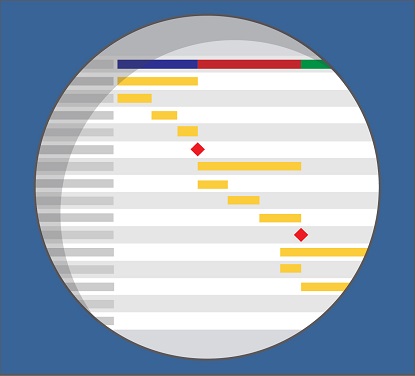
Choosing PM software
If your SME or company is about to choose project management software, you probably don't know where to start looking for the right PM tool for you. This guide will guide you through the PM software market and lead you to the right decision in 9 steps.

7 advantages of PM software
From better Excel spreadsheets to comprehensive business coordination software: what advantages does project management software offer and for whom is it worth buying a PM tool? We provide 7 good reasons why your company will benefit from project management software.

Software implementation
The introduction of business software is complex. What implementation strategies are there? Which strategy is suitable for which purpose? With this knowledge, you can lead your implementation project to success.

Project communication
One of the main reasons for project failure is a lack of project communication - according to a PMI study, communication management in a project is just as important as an accurate cost estimate, a clear definition of project goals and a thorough risk analysis. 3 practical tips for your project communication!

